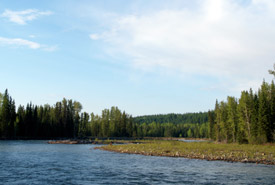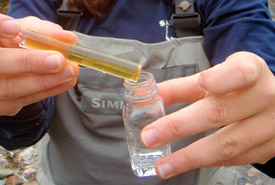Fresh water 101

Vista from Flathead River Ranch, British Columbia (Photo by NCC)
"Water. Canada. The words are as inextricably linked in our Canadian culture as maple and syrup, or Stanley and Cup. And despite our reverence for the liquid of life, the evidence is compelling that we are over-using and abusing water, to our collective environmental and economic detriment…’’ ~ David Boyd (2004) in the foreword to The Future in Every Drop.
An ecosystem at risk
Although 70 per cent of Earth is covered in water, only three per cent is fresh water found in lakes, rivers, wetlands, glaciers and groundwater. Ten per cent of all known animals on Earth rely on freshwater ecosystems. Beyond fish, fresh water provides habitat for turtles, frogs, snails, molluscs, birds, beavers, otters and various insects. Unfortunately, freshwater wildlife populations have declined by an average of 84 per cent since 1970, faster than any other biome on Earth.
From 1970 to 2000, the health of the world’s freshwater ecosystems declined by 50 per cent. More than one-half of the world’s major rivers have been seriously depleted and polluted and over half of the world’s wetlands have been eliminated. Reasons for this deterioration are easily understood; the world’s growing human population uses fresh water for a vast range of services, including electricity, drinking water, waste removal, agriculture, transportation, manufacturing, fishing, flood control and recreation. In doing so, freshwater ecosystems are fragmented, disrupted, starved, contaminated and sometimes completely eliminated. Invasive species are also an issue. Conserving freshwater ecosystems is crucial to both maintaining habitat for species at risk and supporting human well-being.
Freshwater ecosystem classification

Water sampling at Darkwoods (Photo by NCC)
While much is known about Canada’s terrestrial ecosystems, and a well-established land-based classification system exists, surprisingly little is known about aquatic ecosystems. However, just as a coastal western hemlock forest is different from a spruce-willow-birch forest, not all rivers and not all lakes are alike in their physical habitat, hydrologic regime (distribution and movement of water over time), water chemistry and temperature, connectivity or interactions of organisms. The diversity of freshwater organisms across Canada is a testament to the diversity of our country’s river and lake ecosystems. Yet, surprisingly, no established freshwater ecosystem classification exists. For proper freshwater conservation, it is essential to characterize these river and lake ecosystems based on their dominant environmental processes, physical habitat and what is known of the species found there.
Did you know…
- The major source of fresh water is from evaporation off the surface of the oceans; approximately 434,000 km3/year.
- Canada has the third most renewable fresh water in the world, after Brazil and Russia, containing seven per cent of the global supply of renewable fresh water. Renewable fresh water is that which can be replenished by precipitation. Water is non-renewable when the source cannot be replenished, such as an underground reservoir.
- Canada's rivers discharge seven per cent of the world's renewable water supply, annually.
- Almost nine per cent, or 891,163 square kilometres, of Canada's total area is covered by fresh water.
- The Great Lakes Basin (shared with the United States) is the world's largest freshwater lake system.
- Approximately 60 per cent of Canada's fresh water drains to the north, while 85 per cent of the population lives along the southern border with the United States.
- The largest river basin in Canada is the Mackenzie Basin, based on drainage area and length.
- Canada’s lakes and rivers cover about 12 per cent of the country’s surface area.
- There are more than 8,500 named rivers in Canada.
What is NCC doing to protect freshwater ecosystems?
The Nature Conservancy of Canada (NCC) has been leading the way in the development of ecosystem classifications for rivers and lakes throughout the entire province of British Columbia as well as the Ontario portion of the Great Lakes basin.
- To foster wetland conservation across British Columbia, NCC’s BC region hired five wetland technicians in 2021 as a part of the Wetlands Workforce, a provincial initiative led by the BC Wildlife Federation to maintain and monitor wetlands. With funding and support from the Healthy Watersheds Initiative and the Province of BC, the wetland assessments and inventories completed by the Wetlands Workforce will contribute to a better understanding of wetland health in the province. This region has a long-term commitment to protect and restore wetlands, which are critical habitats for many species-at-risk, such as northern leopard frog.
- The Wetlands Workforce has been actively restoring wetlands at NCC conservation areas across BC since 2021, sharing knowledge and collaborating with our BC region staff. Wetlands at NCC’s Chase Woods Conservation Area are undergoing revegetation with native plant species to outcompete the growth of invasive grasses by shoreline areas. At Lac du Bois conservation area on BC’s mainland, restoration activities, such as shoreline clean ups, invasive species removal and protective fencing installations, have all taken place while the Wetland Workforce and NCC assess for wetland health.
- In Saskatchewan, NCC’s Buffalo Pound property consists of 866 hectares of native grasslands and seven kilometres of shoreline along the north shore of Buffalo Pound Lake. Located 40 kilometres from Moose Jaw, this lake is important because it stores the drinking water for a quarter of the province’s population, including Regina and Moose Jaw. The native grasslands around the lake help filter the water, trap carbon and hold back flood waters.
- In Quebec, NCC helped found the Chaire Eau et conservation du territoire and is its main research-action partner. The chair's mission is to better understand how groundwater feeds natural environments in order to facilitate the protection of ecosystems.
- In 2017, NCC launched the Quebec Ecological Corridors Initiative. Made up of 10 organizations from 11 regions in Quebec, the initiative is proposing a collective approach to land use planning and aims to promote aquatic connectivity.




